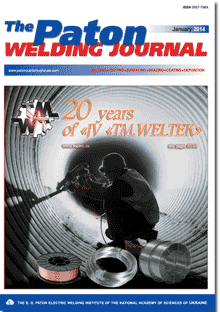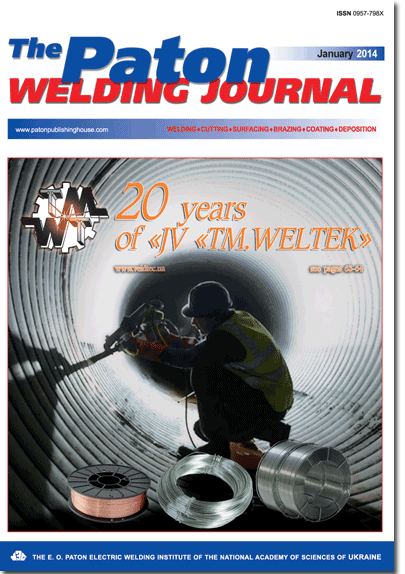| 2014 №01 (03) |
DOI of Article 10.15407/tpwj2014.01.04 |
2014 №01 (05) |

The Paton Welding Journal, 2014, #1, 25-29 pages
IMPROVEMENT OF POWER EFFICIENCY OF MACHINES FOR RESISTANCE SPOT WELDING BY LONGITUDINAL COMPENSATION OF REACTIVE POWER
A.A. PISMENNY
E.O. Paton Electric Welding Institute, NASU. 11 Bozhenko Str., 03680, Kiev, Ukraine. E-mail: office@paton.kiev.ua
Abstract
Considered is the operation of supply system of a single-phase machine for resistance spot welding (RSW) with introducing of scheme of longitudinal compensation of reactive power into the primary circuit of welding transformer. Machines for RSW are characterized by a high consumed power, the significant part of which is a reactive component. This leads to increase in general installed power of working regions and asymmetry of loading phases of supply distribution three-phase mains. It is shown in the work that system with a longitudinal compensator is well interacted with a standard thyristor controller of power of machine and allows keeping a high value of power factor within the range of phase control up to 60°. The application of longitudinal compensation gives technological advantages of spot welding, as the power factor of machine with a compensator depends little on the resistance of welding contact. Therefore the welding of metals in the wide range of specific resistances is possible: from low-carbon steels up to some light alloys and metals with protective coatings. Low cost of additional equipping of existing machines with longitudinal compensator with a simultaneous improvement of their technological properties makes the method of longitudinal compensation challenging for industrial application. 7 Ref., 1 Table, 4 Figures.
Keywords: resistance spot welding, power system, compensation of reactive power, power factor
Received: 27.03.13
Published: 28.01.14
References
1. Lebedev, V.K., Pismenny, A.A. (2001) Power systems of resistance welding machines. The Paton Welding J., 11, 28-32.
2. Lebedev, V.K., Pismenny, A.A. (2003) Power system of flash-butt welding machines with a transistor inverter. Ibid., 2, 10-12.
3. Zorin, V.V. (1960) Compensation of reactive power of resistance machines by series capacitors. Avtomatich. Svarka, 6, 28-36.
4. Glebov, L.V., Filippov, Yu.I., Chuloshnikov, P.L. (1987) Structure and operation of resistance machines. Leningrad: Energoatomizdat.
5. Paton, B.E., Lebedev, V.K. (1969) Electric equipment for resistance welding. Moscow: Mashinostroenie, 59, 302, 342.
6. Pismenny, A.A. (2008) Increase in efficiency of supply systems of resistance spot welding machines: Syn. of Thesis for Cand. of Techn. Sci. Degree. Kiev.
7. Koubek, P. (2006) Energeticke aspekty pouzivania zvaracich strojov s trojfazovym napajanim. Zvaranie-Svarovani, 10, 288-292.
Suggested Citation
A.A. PISMENNY (2014) IMPROVEMENT OF POWER EFFICIENCY OF MACHINES FOR RESISTANCE SPOT WELDING BY LONGITUDINAL COMPENSATION OF REACTIVE POWER. The Paton Welding J., 01, 25-29.The cost of subscription/purchase order journals or individual articles
| Journal/Currency | Annual Set | 1 issue printed |
1 issue |
one article |
| TPWJ/USD | 384 $ | 32 $ | 26 $ | 13 $ |
| TPWJ/EUR | 348 € | 29 € | 24 € | 12 € |
| TPWJ/UAH | 7200 UAH | 600 UAH | 600 UAH | 280 UAH |
| AS/UAH | 1800 UAH | 300 UAH | 300 UAH | 150 UAH |
| AS/USD | 192 $ | 32 $ | 26 $ | 13 $ |
| AS/EUR | 180 € | 30 € | 25 € | 12 € |
| SEM/UAH | 1200 UAH | 300 UAH | 300 UAH | 150 UAH |
| SEM/USD | 128 $ | 32 $ | 26 $ | 13 $ |
| SEM/EUR | 120 € | 30 € | 25 € | 12 € |
| TDNK/UAH | 1200 UAH | 300 UAH | 300 UAH | 150 UAH |
| TDNK/USD | 128 $ | 32 $ | 26 $ | 13 $ |
| TDNK/EUR | 120 € | 30 € | 25 € | 15 € |
AS = «Automatic Welding» - 6 issues per year;
TPWJ = «PATON WELDING JOURNAL» - 12 issues per year;
SEM = «Electrometallurgy Today» - 4 issues per year;
TDNK = «Technical Diagnostics and Non-Destructive Testing» - 4 issues per year.


